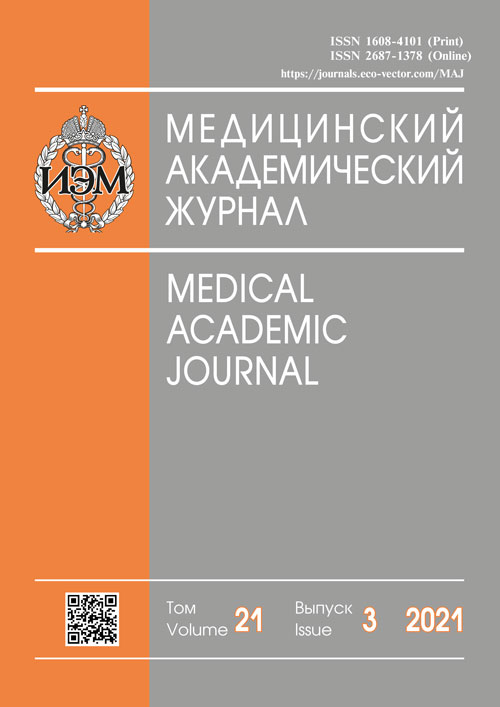Деструктивное действие РНКазы А на вирус SARS-CoV-2 (исследование in vitro)
- Авторы: Морозов И.А.1, Годовалов А.П.1, Оборин Д.А.2
-
Учреждения:
- Пермский государственный медицинский университет им. акад. Е.А. Вагнера
- Пермский краевой центр по профилактике и борьбе со СПИД и инфекционными заболеваниями
- Выпуск: Том 21, № 3 (2021)
- Страницы: 131-134
- Раздел: Материалы конференции
- Статья опубликована: 06.12.2021
- URL: https://journals.eco-vector.com/MAJ/article/view/76133
- DOI: https://doi.org/10.17816/MAJ76133
- ID: 76133
Цитировать
Полный текст
Аннотация
Обоснование. На сегодняшний день самым главным и обсуждаем вопросом в профессиональном медицинском сообществе остается проблема профилактики и лечения новой коронавирусной инфекции (COVID-19). Среди причин не спадающего роста заболеваемости и смертности доминирует отсутствие препарата этиотропного действия. В нашем исследовании предлагается использовать выпускаемый ранее для лечения клещевого энцефалита препарат рибонуклеазы А, получаемый из поджелудочной железы крупного рогатого скота.
Цель — изучить противовирусную активность РНКазы А в отношении SARS-CoV-2 в экспериментах in vitro.
Материалы и методы. В эксперименте применяли пробы 50 пациентов с подтвержденным (методом полимеразной цепной реакции) первичным диагнозом новой коронавирусной инфекции (COVID-19). Препаратом для исследования служила рибонуклеаза A (neoFroxx GmbH, Германия) в концентрациях 0,5; 1; 5 и 10 мг/мл. Пробы инкубировали при 4 и 37 °С, экспозиция — 20 мин и 20 ч. Полимеразную цепную реакцию проводили с использованием набора реагентов ОТ-ПЦР-РВ-SARS-CoV-2 (ООО «Синтол», Россия).
Результаты. Выявлена противовирусная активность рибонуклеазы А в минимальной концентрации 0,5 мг/мл при инкубации 20 мин и 20 ч в температурном диапазоне от 4 до 37 °С.
Заключение. Полученные в исследовании in vitro данные о способности рибонуклеазы А разрушать вирусную РНК предполагают возможность применения препарата как для лечения пациентов, так и для обработки объектов окружающей среды.
Ключевые слова
Полный текст
Об авторах
Илья Андреевич Морозов
Пермский государственный медицинский университет им. акад. Е.А. Вагнера
Автор, ответственный за переписку.
Email: Lonny8@yandex.ru
ORCID iD: 0000-0003-4233-3711
студент лечебного факультета
Россия, ПермьАнатолий Петрович Годовалов
Пермский государственный медицинский университет им. акад. Е.А. Вагнера
Email: agodovalov@gmail.com
д-р мед. наук, ведущий научный сотрудник центральной научной лаборатории, доцент кафедры микробиологии и вирусологии
Россия, ПермьДенис Александрович Оборин
Пермский краевой центр по профилактике и борьбе со СПИД и инфекционными заболеваниями
Email: DAOborin@yandex.ru
врач-бактериолог
Россия, ПермьСписок литературы
- Романов Б.К. Коронавирусная инфекция COVID-2019 // Безопасность и риск фармакотерапии. 2020. Т. 8, № 1. С. 3–8. doi: 10.30895/2312-7821-2020-8-1-3-8
- Никифоров В.В., Суранова Т.Г., Чернобровкина Т.Я. и др. Новая коронавирусная инфекция (COVID-19): клинико-эпидемиологические аспекты // Архивъ внутренней медицины. 2020. Т. 10, № 2(52). С. 87–93. doi: 10.20514/2226-6704-2020-10-2-87-93
- Абатуров А.Е., Агафонова Е.А., Кривуша Е.Л., Никулина А.А. Патогенез COVID-19 // Здоровье ребенка. 2020. Т. 15, № 2. С. 133–144. doi: 10.22141/2224-0551.15.2.2020.200598
- Rosenberg H.F. RNase A ribonucleases and host defense: an evolving story // J. Leukoc. Biol. 2008. Vol. 83, No. 5. P. 1079–1087. doi: 10.1189/jlb.1107725
- Абатуров А.Е. Рибонуклеазы А — древнейшие компоненты неспецифической защиты респираторного тракта // Здоровье ребенка. 2011. Т. 5, № 32. С. 136–142.
- Ильинская О.Н., Шах Махмуд Р. Рибонуклеазы как противовирусные агенты // Молекулярная биология. 2014. Т. 48, № 5. С. 707. doi: 10.7868/S0026898414040053
- Dyer K.D., Rosenberg H.F. The RNase a superfamily: generation of diversity and innate host defense // Mol. Divers. 2006. Vol. 10, No. 4. P. 585–597. doi: 10.1007/s11030-006-9028-2
Дополнительные файлы









